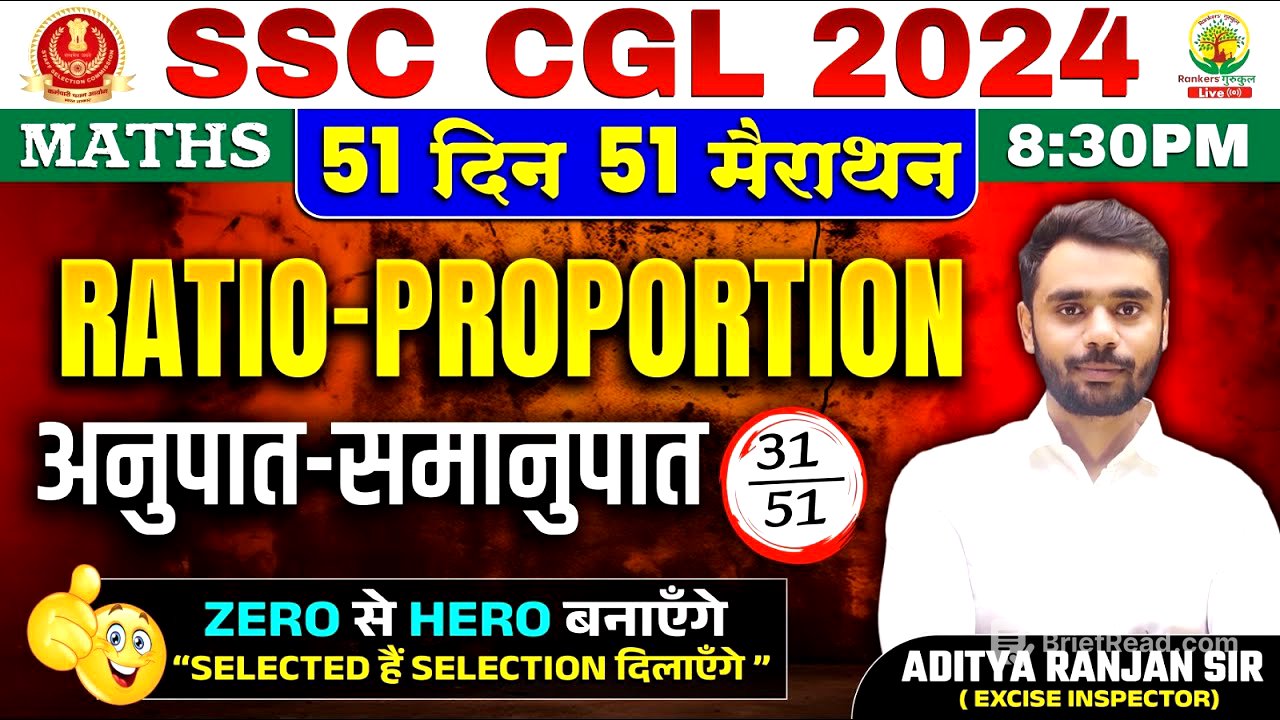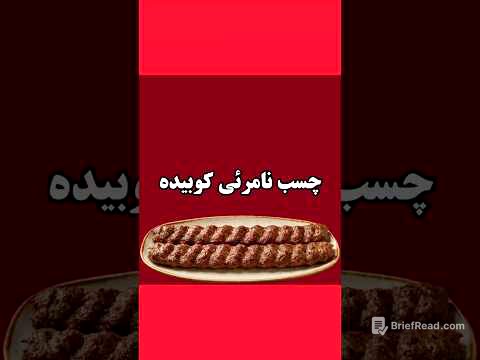TLDR;
This YouTube video by Rankers Gurukul is the first part of a marathon class on ratio and proportion. The instructor emphasizes a commitment to comprehensive teaching, covering all topics and exam types. The video includes explanations of ratio concepts, various question types, and shortcut tricks to solve problems quickly. The instructor also discusses the importance of mental calculation and understanding the underlying concepts.
- Comprehensive coverage of ratio and proportion topics.
- Emphasis on shortcut tricks and mental calculation.
- Discussion of different question types and exam strategies.
Introduction [0:12]
The instructor welcomes everyone to the class, expressing his commitment to covering all topics in mathematics systematically. He shares anecdotes about students' progress and emphasizes the importance of consistent practice. He also mentions an upcoming mock test series. The instructor assures students that the syllabus will be completed thoroughly.
Ratio: Definition and Comparison [1:49]
The class begins with the definition of ratio as a comparison of two quantities of the same kind, such as height or weight. The instructor explains that ratios are dimensionless and should be expressed in their simplest form. He also clarifies that a ratio is essentially a division of two numbers, represented as a fraction.
Type 1: Finding Combined Ratios [5:45]
The instructor introduces the first type of ratio problem: finding the combined ratio of three variables (A, B, and C) when given individual ratios (A:B and B:C). He presents two methods to solve this type of problem. The first method involves occupying adjacent spaces in a ratio table, while the second method involves multiplying ratios and simplifying.
Method 1: Occupation Method [7:07]
The occupation method is explained using an analogy of occupying houses in a lane. The ratios A:B and B:C are written in separate lines, and the empty spaces are filled with the adjacent numbers. Then, the numbers in each column are multiplied to get the combined ratio A:B:C.
Method 2: Multiplication and Simplification [9:02]
The multiplication method involves multiplying the ratios in a specific sequence. First, multiply the first terms of A:B and B:C. Then, multiply the terms diagonally, and finally, multiply the last terms. The instructor illustrates this with examples, emphasizing the importance of simplifying the resulting ratio.
Extending to Four Variables [10:10]
The instructor extends the concept to finding the ratio of four variables (A:B:C:D) when given individual ratios (A:B, B:C, and C:D). He demonstrates how to apply both the occupation method and the multiplication method to solve this type of problem.
Question 1: School Bag and Dress Prices [13:33]
The first question involves finding the cost of a school dress given the ratio of the prices of a school bag and dress, and the difference in their prices. The instructor explains how to find the value of one unit in the ratio and then calculate the cost of the dress.
Question 2: Finding Ratio of A:B:C:D [15:13]
The second question involves finding the ratio of A:B:C:D given the individual ratios of A:B, B:C, and C:D. The instructor demonstrates the traditional method of filling in the blanks and multiplying, but also introduces a shortcut method to save time.
Shortcut Method: Using Options [19:43]
The instructor introduces a shortcut method to solve ratio problems quickly by focusing on the given ratios in the options. He explains that if the ratio of A:B is 8:13, then the correct option must have A and B in the same ratio. This method helps eliminate options and save time.
Question 3: Ratio of x/y, y/z, and z/x [21:49]
The third question involves finding the ratio of x/y, y/z, and z/x given the values of x, y, and z. The instructor explains the basic method of substituting the values and finding the LCM, but also introduces a shortcut method to solve the problem quickly.
Shortcut Method: Focusing on Key Ratios [23:41]
The instructor explains that instead of finding all the individual ratios, one can focus on the key ratios required in the question. By multiplying the given values and simplifying, the answer can be obtained quickly.
Question 4: Finding Ratio of x and y, y and z [24:57]
The fourth question involves finding the ratio of x and y, and y and z given an equation relating x, y, and z. The instructor demonstrates how to solve the problem using both the basic method and a shortcut method.
Shortcut Method: Comparing Ratios [26:09]
The instructor explains that instead of solving the entire equation, one can compare the ratios of x and y, and y and z in the options. By eliminating options that do not match the given ratios, the correct answer can be found quickly.
Question 5: Finding Ratio of p, q, r, and s [27:17]
The fifth question involves finding the ratio of p, q, r, and s given the individual ratios of p:q, q:r, and r:s. The instructor demonstrates the traditional method of filling in the blanks and multiplying, but also introduces a shortcut method to solve the problem quickly.
Shortcut Method: Preeti Method [29:54]
The instructor introduces a shortcut method called the "Preeti Method" to solve ratio problems quickly. This method involves multiplying the first terms of all the ratios to get the first term of the combined ratio, and multiplying the last terms of all the ratios to get the last term of the combined ratio.
Applying Preeti Method [30:57]
The instructor applies the Preeti Method to another example, demonstrating how to find the ratio of A:E given the individual ratios of A:B, B:C, C:D, and D:E. He emphasizes the importance of canceling out common terms to simplify the calculation.
Question 6: Sum of Four Numbers [32:16]
The sixth question involves finding the value of C given the sum of four numbers (A, B, C, and D) and the individual ratios of A:B, B:C, and C:D. The instructor demonstrates how to find the combined ratio of A:B:C:D and then calculate the value of C.
Question 7: Finding p+q [33:54]
The seventh question involves finding the value of p+q given the ratios of p:q, q:r, and r:p. The instructor demonstrates how to solve the problem using both the basic method and a shortcut method.
Shortcut Method: Using Factors [35:36]
The instructor explains that instead of solving the entire equation, one can focus on the factors of the given ratios. By identifying the factors of p+q in the options, the correct answer can be found quickly.
Question 8: Ratio of c/d and d/e [36:51]
The eighth question involves finding the ratio of c/e given the ratios of c/d and d/e. The instructor demonstrates how to solve the problem by multiplying the ratios and simplifying.
Type 2: Equal Ratios [38:08]
The instructor introduces the second type of ratio problem: finding the ratio of A:B:C when given an equation relating A, B, and C (e.g., 2A = 3B = 4C). He presents two methods to solve this type of problem.
Method 1: LCM Method [39:02]
The LCM method involves finding the LCM of the coefficients of A, B, and C, and then dividing each term by the LCM. The resulting values will be the ratio of A:B:C.
Method 2: Covering Method [40:29]
The covering method involves covering the term whose value is to be found, and then multiplying the coefficients of the remaining terms. The resulting values will be the ratio of A:B:C.
Question 9: Finding p:q:r:s [41:52]
The ninth question involves finding the ratio of p:q:r:s given an equation relating p, q, r, and s (e.g., 2p = 3q = 4r = 5s). The instructor demonstrates how to apply the covering method to solve this type of problem.
Shortcut Method: Comparing Two Ratios [43:55]
The instructor introduces a shortcut method to solve ratio problems quickly by focusing on comparing two ratios at a time. By comparing the ratios of p:q and r:s in the options, the correct answer can be found quickly.
Question 10: Difference of A and C [47:25]
The tenth question involves finding the value of B given the ratio of A:B and B:C, and the difference between A and C. The instructor demonstrates how to find the combined ratio of A:B:C and then calculate the value of B.
Book Promotion [48:25]
The instructor promotes his book, highlighting its comprehensive coverage of mathematics concepts and its usefulness for revision.
Question 11: Dividing Money Between Cyrus, Rohan, and Misteen [49:34]
The eleventh question involves dividing money between Cyrus, Rohan, and Misteen given the individual ratios of Cyrus:Rohan and Rohan:Misteen. The instructor demonstrates how to find the combined ratio of Cyrus:Rohan:Misteen and then calculate the value of Misteen.
Question 12: Dance Class Students [50:55]
The twelfth question involves finding the initial number of students in three dance classes given that the number of students in each class is increased by 20, and the new ratio of students is given. The instructor demonstrates how to find the value of one unit in the ratio and then calculate the initial number of students.
Question 13: Dividing Money Incorrectly [52:01]
The thirteenth question involves dividing money incorrectly among four people (Aman, Ram, Ramesh, and Naresh) and finding who benefited the most and by how much. The instructor demonstrates how to find the correct and incorrect ratios, equalize the sums, and then calculate the profit or loss for each person.
Question 14: Subtracting from Two Numbers [55:48]
The fourteenth question involves subtracting a number from two numbers and finding the smaller number. The instructor demonstrates three methods to solve this type of problem: basic method, cross multiplication method, and difference method.
Difference Method [56:31]
The instructor explains the difference method, which involves making the differences between the ratios equal and then finding the value of one unit.
Cross Multiplication Method [58:18]
The instructor explains the cross multiplication method, which involves cross multiplying the ratios and then finding the value of one unit.
Question 15: Adding and Subtracting from Two Numbers [59:34]
The fifteenth question involves adding a number to the smaller number and subtracting a number from the larger number, and then finding the original numbers. The instructor demonstrates how to solve the problem using the cross multiplication method.
Question 16: Subtracting from Both Numbers [1:01:11]
The sixteenth question involves subtracting a number from both numbers and then adding a number to both numbers, and then finding the new numbers. The instructor demonstrates how to solve the problem using the difference method.
Question 17: Coin Questions [1:03:58]
The instructor introduces coin questions, which involve finding the number of coins of different denominations given the total amount and the ratio of the number of coins.
Solving Coin Questions [1:05:19]
The instructor explains the steps to solve coin questions, which involve finding the value of each denomination, finding the total value, and then calculating the number of coins of each denomination.
Question 18: Using Coins of Different Denominations [1:07:34]
The eighteenth question involves using coins of different denominations to pay a certain amount. The instructor demonstrates how to solve the problem using the option method.
Option Method [1:10:05]
The instructor explains the option method, which involves substituting the values from the options and checking if they satisfy the given conditions.
Question 19: Radhika and Bank Cashier [1:11:46]
The nineteenth question involves finding the value of the smallest coin given the total amount and the ratio of the number of coins of different denominations. The instructor demonstrates how to solve the problem by finding the total value of the coins and then calculating the value of the smallest coin.
Comment Box Question [1:13:30]
The instructor asks the students to answer a question in the comment box.
Question 20: Coffee and Tea Prices [1:14:07]
The twentieth question involves finding the ratio of expenditure on coffee and tea given the ratio of their prices and the ratio of their quantity. The instructor demonstrates how to solve the problem by multiplying the ratios and simplifying.
Question 21: Expenditure and Saving of a Person [1:15:20]
The twenty-first question involves finding the new ratio of expenditure and saving of a person given that the saving is increased by a certain amount and the income remains the same. The instructor demonstrates how to solve the problem by finding the new expenditure and saving and then calculating the new ratio.
Shortcut Method: No Change in Income [1:17:22]
The instructor explains a shortcut method to solve the problem quickly by focusing on the fact that there is no change in income.
Batch Information [1:18:59]
The instructor provides information about his recorded and live batches, highlighting their features and benefits.
Remaining Questions [1:22:00]
The instructor discusses the remaining questions and their difficulty levels, promising to cover them in the next class.
Ending [1:23:56]
The instructor ends the class, thanking the students for their participation and promising to continue in the next session.









